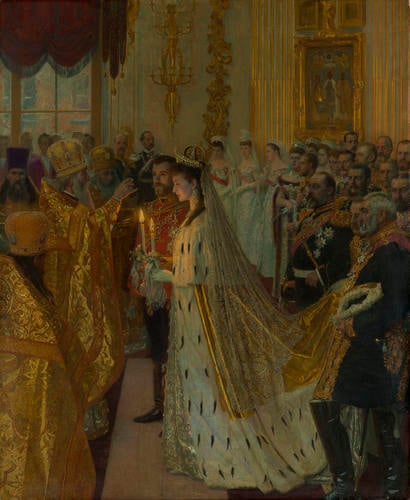The Marriage of Nicholas II, Tsar of Russia, 26th November 1894 Dated 1895-6
Oil on canvas | 169.4 x 139.9 cm (support, canvas/panel/stretcher external) | RCIN 404465

Laurits Regner Tuxen (1853-1927)
The Marriage of Nicholas II, Tsar of Russia, 26th November 1894 Dated 1895-6
-
The wedding between Nicholas II and Princess Alix of Hesse took place in the Imperial Chapel of the Winter Palace on 26 November 1894, just over twenty years after the marriage of the Tsar's aunt in the same chapel (RCIN 404476). The wedding was announced in April that year and was to take place on the Empress Marie Feodorovna's birthday. Tragically, Emperor Alexander III died of kidney disease on 1 November, and the court was thrown into mourning with the exception of the day of the marriage.
The royal couple stand, holding lighted candles, whilst the Metropolitan Archbishop of St Petersburg, Mgr Palladius, makes the sign of the cross before them. Ella, (Grand Duchess Elizabeth Feodorovna), writing to her grandmother, Queen Victoria, described her sister's dress as 'embroidered silver cloth Russian court dress & very pretty', helpfully including a sketch. She added that 'Alix being tall will look perfectly lovely'. She wears a kokoshnik tiara and a small diamond crown, beneath which is a wreath of orange blossom, her imperial gold-embroidered mantle is lined with ermine. The Tsar is dressed in the uniform of a Hussar. In the background George I, King of Greece stands to the left of Christian IX, King of Denmark, who looks towards his daughter, the Dowager Empress; the Princess of Wales, and the Queen of Greece. The Prince of Wales can be seen dressed in the uniform of Russian Dragoons to the right of the portrait.
Laurits Tuxen was commissioned to paint two pictures of the wedding; a smaller one for the Dowager Empress (1895, Hermitage) and one on a larger scale for Queen Victoria. He varied the combination and placing of figures varying according to the patron. The artist's Autobiography, En Malers Arbejde documents the genesis of both paintings, although it is sometimes difficult to discern which painting he is referring to. Tuxen travelled to St Petersburg on the 20 October 1894, he visited the Winter Palace on 24 November and the following day sketched in the Chapel. On the day of the wedding the artist found himself stationed with the choir; here he took advantage of the steps leading up to the pulpit and from this vantage point was 'intoxicated by the beauty of the scene, the singing, the richness of the colours, the light and the golden fabrics'. He likened the bride's head, softly illuminated from beneath to a 'Luini or a Leonardo'. The poignancy of the day was not lost on General Ellis, who, writing to Queen Victoria described how on this 'gloomy sunless day…a shadow of sadness seemed to hang over the whole ceremony, wh Yr Majesty can well realize'. The following day the Court were to return to the deepest mourning.
For the next sixteen months the artist was at work on the two pictures; travelling to Tsarskoe Selo in May 1895 to sketch and photograph the Tsarina and Tsar, whom he found 'easy and friendly' and to London in July. On 11 September, Tuxen noted that he had started to paint the Queen's version and both pictures were to occupy him until the end of the year. He worked on the bridal couple last, with his wife standing in for the Tsarina.
Signed and dated: L. Tuxen. 1895-9
Text adapted from Russia: Art Royalty & the Romanovs, London 2018Provenance
Commissioned by Queen Victoria (Tuxen was paid on 15 August 1896); sent to Osborne, 10 July 1897 (New Wing Corridor); Buckingham Palace 1901; King's Corridor, Buckingham Palace in 1909.
-
Creator(s)
-
Medium and techniques
Oil on canvas
Measurements
169.4 x 139.9 cm (support, canvas/panel/stretcher external)
203.7 x 174.9 x 9.3 cm (frame, external)
Category
Object type(s)
Other number(s)
Alternative title(s)
The marriage of Nicholas II, Emperor of Russia (1868–1918), 26th November 1894









